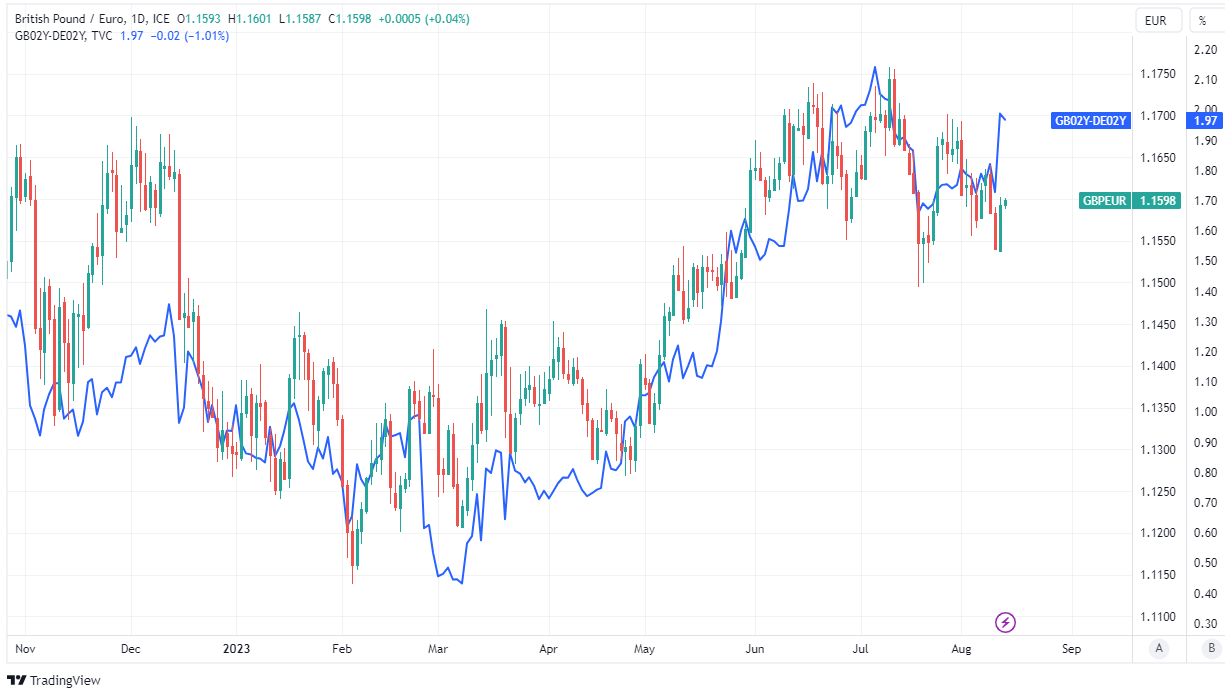GBP/EUR Week Ahead Forecast: Key Averages Confine as Data Eyed
- GBP/EUR supported near 1.1534 & 1.1522 short-term
- Rough 1.1535 to 1.1630 trading range possible ahead
- Key averages at 1.1534 & 1.1639 also likely to confine
- UK’s employment data, inflation & retail sales in focus
- Europe economy surveys, GDP, trade & inflation eyed

Image © Adobe Images
The Pound to Euro exchange rate has held above two-month lows and technical support offered by its 50-day moving average in recent trade, which could be set to underpin the pair again this week but with technical resistance also potentially found around 1.1639 in what is an economic data-heavy week.
Sterling entered the new week trading comfortably above the two-month lows seen against the Euro in mid-July after bouncing off its 50-day moving average at 1.1534 following the release of much stronger than expected UK economic growth figures for the second quarter on Friday last week.
Second quarter economic growth was real but owed in large part to statistical base effects created by the ordering of public holidays this year and last, though it’s the outcome and implications of employment, inflation and retail sales figures due out between Tuesday and Friday that will determine how the Pound fares this week.
“The market now expects just under two rate hikes from current levels of 5.25% until year-end. Even that is questionable and of course mainly depends on the data publications,” says You-Na Park-Heger, a currency analyst at Commerzbank.
“The BoE had kept the door open for further monetary policy tightening last week, but the fact that it decided in favour of a smaller 25bp step illustrated once again that it only seems to be willing to do the absolute minimum, as it is concerned about stifling the economy,” she adds in a Friday research briefing.
Above: Pound to Euro shown at daily intervals with Fibonacci retracements of February rally indicating possible areas of technical support while selected moving averages denote possible support and/or resistance for Sterling. Click image for closer inspection.
The impact of economic data on economists and market forecasts for the Bank of England (BoE) Bank Rate is likely to be the foremost influence on the Pound and with current levels of both taken into account, the risks are tilted more toward the downside for Sterling and rate expectations on a multi-week basis.
“EUR/GBP seems happy to trace out an 0.8600-0.8650 [GBP/EUR: 1.1560 to 1.1627] range for the time being. But we are happy with our upside bias towards the 0.88 area [1.1360] for later in the year,” says Chris Turner, global head of markets and regional head of research for UK & CEE at ING.
The Bank of England raised interest rates from 0.1% to 5.25% between December 2021 and early August, making it the first major central bank to begin raising borrowing costs in response to rising inflation while leaving the UK economy with by far the ‘tightest’ monetary policy in the advanced economy universe relative to the pre-pandemic norm.
But while economists and financial markets widely assume that further increases in Bank Rate will be announced before year-end, the BoE itself was non-committal in its outlook and language in the August Monetary Policy Report and accompanying press conference, hence why this week’s data is likely of more importance than usual.
“Granted, the U.K. is still the only G7 country in which the main quarterly measure of GDP has not yet surpassed its pre-Covid peak; it was 0.2% below its Q4 2019 level in Q2,” says Samuel Tombs, chief UK economist at Pantheon Macroeconomics.
Above: Quantitative model estimates of possible ranges for the week. Source: Pound Sterling Live.
“But the details in last week’s GDP report provides reassurance that Q2’s faster rate of growth can be sustained over the coming quarters,” he adds in a Friday research note.
Wednesday’s release of inflation figures for July is the highlight of the week and month given their potentially significant implications for the Bank of England (BoE) interest rate outlook but the knock-on effect for the Pound is likely to be a dampening one if the economist consensus is anything to go by.
The consensus suggests inflation likely fell sharply to around 6.9% in July with the more important core inflation rate dipping from 6.9% to 6.8% owing to statistical base effects and other factors have impacted food and energy price inflation.
However, and beforehand, the Pound potentially stands to benefit on Tuesday if it turns out the economist consensus is right to anticipate further increases in both main measures of average wage growth in the employment figures for June.
“The preference remains to cast the net towards the crosses, where GBPAUD, GBPNZD or GBPJPY have been solid plays and will need to big downside UK core CPI print to halt the bullish trends,” says Chris Weston, chief market analyst at Pepperstone.
Above: Pound to Euro shown at daily intervals with spread or gap between 02-year UK and German government bond yields. Click image for closer inspection.
When workforce bonuses are set aside, average annual wage growth rose above 7% in April following a near double-digit percentage increase in the national minimum wage and remained unchanged at the same level in May but remains to be seen if and how such a rate of pay growth could be sustained into June.
Nonetheless, the economist consensus is for a further uptick from 7.3% to 7.4% on Tuesday ahead of the midweek inflation report and the retail sales figures out on Friday, the latter of which forecasters are less optimistic about: The average of economist forecasts suggests June's 0.7% increases was partially reversed by a -0.4% fall in Jult.
The UK data is interspersed with releases of the ZEW German economy survey as well as second estimates of second quarter GDP and July inflation for the Euro Area, in addition to the latest reading of the trade balance, though whether either is enough to lift the Euro remains to be seen.
“With UK inflation more elevated and the BoE signaling most clearly the potential to hike again, the UK data has the most potential to be market moving,” says Abdul-Ahad Lockhart, a currency analyst at MUFG.
“We have instigated a short EUR/USD trade idea to reflect the potential bias favouring yield and hence the dollar over the short-term,” he adds in a Friday research briefing.



